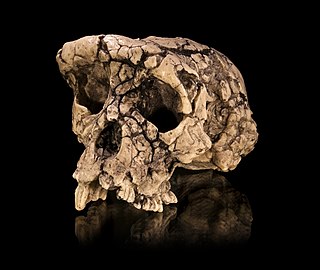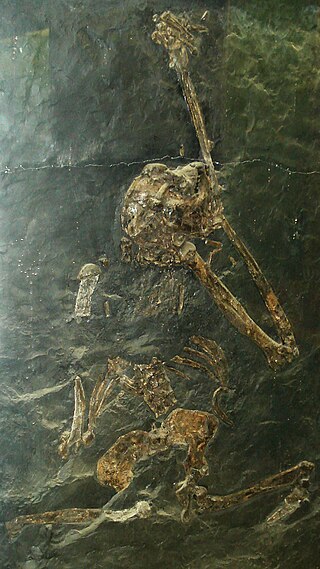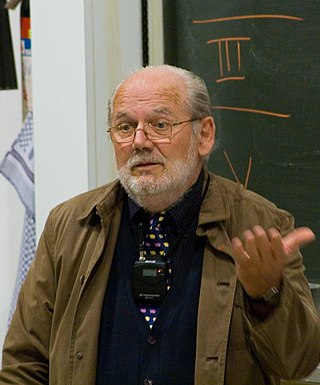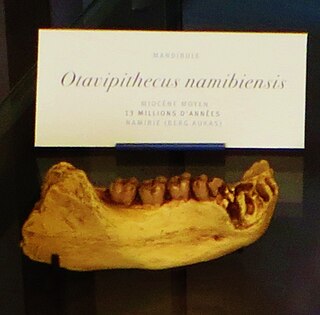
Orrorin tugenensis is a postulated early species of Homininae, estimated at 6.1 to 5.7 million years ago and discovered in 2000. It is not known how Orrorin are related to modern humans. Its discovery was used to argue against the hypothesis that australopithecines are human ancestors, although this remains the most prevalent hypothesis of human evolution as of 2012.

Sahelanthropus tchadensis is an extinct species of the hominid dated to about 7 million years ago, during the Miocene epoch. The species, and its genus Sahelanthropus, was announced in 2002, based mainly on a partial cranium, nicknamed Toumaï, discovered in northern Chad.

Oreopithecus is an extinct genus of hominoid primate from the Miocene epoch whose fossils have been found in today's Tuscany and Sardinia in Italy. It existed nine to seven million years ago in the Tusco-Sardinian area when this region was an isolated island in a chain of islands stretching from central Europe to northern Africa in what was becoming the Mediterranean Sea.

Meave G. Leakey is a British palaeoanthropologist. She works at Stony Brook University and is co-ordinator of Plio-Pleistocene research at the Turkana Basin Institute. She studies early hominid evolution and has done extensive field research in the Turkana Basin. She has Doctor of Philosophy and Doctor of Science degrees.

The Hominini form a taxonomic tribe of the subfamily Homininae ("hominines"). Hominini includes the extant genera Homo (humans) and Pan and in standard usage excludes the genus Gorilla (gorillas).

The Tugen Hills are a series of hills in Baringo County, Kenya. They are located in the central-western portion of Kenya.

Proconsul major, an extinct primate of the genus Proconsul, was possibly the ancestor of Afropithecus and showed hominid characteristics. It occurred during the early Miocene and was roughly, the size of a gorilla. The species previously referred to as Ugandapithecus major is now considered to be a synonym of Proconsul major. Prior to 2000 it was known as Proconsul major and some argue against the renaming.

AL 129-1 is a fossilized knee joint of the species Australopithecus afarensis. It was discovered in Hadar, Ethiopia by Donald Johanson in November 1973.

Michel Brunet is a French paleontologist and a professor at the Collège de France. In 2001 Brunet announced the discovery in Central Africa of the skull and jaw remains of a late Miocene hominid nicknamed Toumaï. These remains may predate the earliest previously known hominid remains, Lucy, by over three million years; however, this conclusion is the subject of a significant controversy.

Hélène Langevin-Joliot is a French nuclear physicist known for her research on nuclear reactions in French laboratories and for being the granddaughter of Marie Curie and Pierre Curie and the daughter of Irene Joliot-Curie and Frédéric Joliot-Curie, all four of whom have received Nobel Prizes, in Physics or Chemistry. Since retiring from a career in research Hélène has participated in activism centered around encouraging women and girls to participate in STEM fields. Her activism also revolves around promoting greater science literacy for the general public.

Martin Pickford is a lecturer in the Chair of Paleoanthropology and Prehistory at the Collège de France and honorary affiliate at the Département Histoire de la Terre in the Muséum national d'Histoire. In 2001, Martin Pickford together with Brigitte Senut and their team discovered Orrorin tugenensis, a hominid primate species dated between 5.8 and 6.2 million years ago and a potential ancestor of the genus Australopithecus.

Samburupithecus is an extinct primate that lived in Kenya during the middle to late Miocene. The one species in this genus, Samburupithecus kiptalami, is known only from a maxilla fragment dated to 9.5 million years ago discovered in 1982 and formally described by Ishida & Pickford 1997. The type specimen KNM-SH 8531 was discovered by the Joint Japan-Kenya Expedition at the SH22 fossil site in the Samburu District, a locality where several other researchers found no ape fossils.

The Hominidae, whose members are known as the great apes or hominids, are a taxonomic family of primates that includes eight extant species in four genera: Pongo ; Gorilla ; Pan ; and Homo, of which only modern humans remain.

Nacholapithecus kerioi was an ape that lived 14-15 million years ago during the Middle Miocene. Fossils have been found in the Nachola formation in northern Kenya. The only member of the genus Nacholapithecus, it is thought to be a key genus in early hominid evolution. Similar in body plan to Proconsul, it had a long vertebral column with six lumbar vertebrae, no tail, a narrow torso, large upper limbs with mobile shoulder joints, and long feet.

Anna Katherine "Kay" Behrensmeyer is an American taphonomist and paleoecologist. She is a pioneer in the study of the fossil records of terrestrial ecosystems and engages in geological and paleontological field research into the ecological context of human evolution in East Africa. She is Curator of Vertebrate Paleontology in the Department of Paleobiology at the Smithsonian Institution's National Museum of Natural History (NMNH). At the museum, she is co-director of the Evolution of Terrestrial Ecosystems program and an associate of the Human Origins Program.
The savannah hypothesis is a hypothesis that human bipedalism evolved as a direct result of human ancestors' transition from an arboreal lifestyle to one on the savannas. According to the hypothesis, hominins left the woodlands that had previously been their natural habitat millions of years ago and adapted to their new habitat by walking upright.

Otavipithecus namibiensis is an extinct species of ape from the Miocene of Namibia. The fossils were discovered at the Berg Aukas mines in the foothills of the Otavi mountains, hence the generic name. The species was described in 1992 by Glenn Conroy and colleagues, and was at the time the only non-hominin fossil ape known from southern Africa. The scientists noted that the surrounding area of the discovered specimen included fauna dated at "about 13 ± 1 Myr". The fossils consist of part of the lower jawbone with molars, a partial frontal bone, a heavily damaged ulna, one vertebra and a partial finger bone.
Micropithecus is an extinct genus of primates that lived in East Africa about 19 to 15 million years ago, during the early Miocene. The genus and its type species, Micropithecus clarki, were first scientifically described in 1978.

Nathalie Demassieux (1884–1961), was a chemist and French academic who specialized in mineral chemistry. She was, after Irène Joliot-Curie and Pauline Ramart, the third woman to obtain a position as a lecturer in a French university. In tribute to her legacy with the Faculty of Sciences of Paris, the Nathalie Demassieux scientific prize was awarded for many years by the Chancellery of the Universities of Paris.

Panina is a subtribe of Hominini comprising all descendants of the human-chimpanzee last common ancestor (LCA) that are not a part of the human lineage; that is, all ancestors of the type genus, Pan. The split occurred around 6-8 mya. Fossils from this subtribe are typically rare because they tend to live in environments with poor fossilization. Some of the earliest chimpanzee fossils are 500,000 years of age.


















